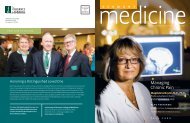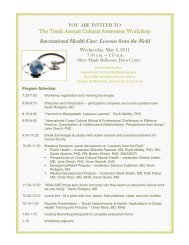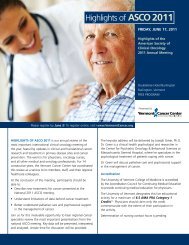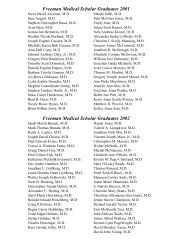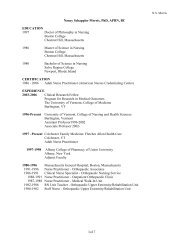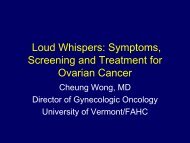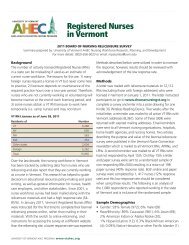What is Migraine and How Is It Treated? - University of Vermont
What is Migraine and How Is It Treated? - University of Vermont
What is Migraine and How Is It Treated? - University of Vermont
You also want an ePaper? Increase the reach of your titles
YUMPU automatically turns print PDFs into web optimized ePapers that Google loves.
Myths <strong>of</strong> <strong>Migraine</strong>:<br />
<strong>What</strong> <strong>is</strong> it? Who gets it?<br />
<strong>What</strong> can you do about it?<br />
Robert E. Shapiro, MD, PhD
About Dr. Shapiro<br />
Robert Shapiro, M.D., Ph.D., <strong>is</strong> a pr<strong>of</strong>essor <strong>of</strong> neurology<br />
<strong>and</strong> director <strong>of</strong> the Headache Clinic at the <strong>University</strong> <strong>of</strong><br />
<strong>Vermont</strong>. Dr. Shapiro earned h<strong>is</strong> medical degree from<br />
Columbia <strong>University</strong>, <strong>and</strong> a Ph.D. in anatomy from the<br />
<strong>University</strong> <strong>of</strong> Pennsylvania. Prior to joining UVM/Fletcher<br />
Allen in 1997, he served a residency in neurology <strong>and</strong><br />
then held positions as an instructor <strong>and</strong> ass<strong>is</strong>tant<br />
pr<strong>of</strong>essor <strong>of</strong> neurology at The Johns Hopkins <strong>University</strong><br />
School <strong>of</strong> Medicine. Active in several pr<strong>of</strong>essional<br />
organizations, Dr. Shapiro <strong>is</strong> a founding president <strong>of</strong><br />
Alliance for Headache D<strong>is</strong>orders Advocacy.
Dr. Shapiro <strong>is</strong> also the organizer <strong>of</strong> ‘Headache on the Hill,’<br />
an annual event designed to reach leg<strong>is</strong>lators to increase<br />
awareness <strong>of</strong> the crucial need for additional funding for<br />
research into migraine <strong>and</strong> other headache d<strong>is</strong>orders.<br />
The recipient <strong>of</strong> several awards for scholarship, Dr.<br />
Shapiro has been actively involved in research activities<br />
throughout h<strong>is</strong> career. H<strong>is</strong> current research <strong>is</strong> focused on<br />
clinical trials to examine the effectiveness <strong>of</strong> medications<br />
for migraine.
Myth #1<br />
<strong>Migraine</strong> <strong>is</strong> just<br />
a bad headache.
<strong>Migraine</strong> <strong>is</strong> NOT Headache<br />
<strong>Migraine</strong> <strong>is</strong> a chronic ep<strong>is</strong>odic state <strong>of</strong> the brain.<br />
Headache <strong>is</strong> a symptom <strong>of</strong> the migraine state.<br />
♦<br />
migraine symptom patterns<br />
♦ idiosyncratic<br />
♦ stereotypic<br />
♦ evolving<br />
♦<br />
migraine susceptibility<br />
♦ heritable<br />
♦ chronobiologic<br />
♦ stimulus-bound
<strong>Migraine</strong> Attacks:<br />
Clinical Features<br />
Prodrome phase: ~ one third <strong>of</strong> patients,<br />
~ hours to days<br />
moodiness, fatigue, GI, muscle stiffness, fluid retention, yawning, cravings<br />
Aura phase: (~ 20 % <strong>of</strong> patients):<br />
< 60 min<br />
symptoms: v<strong>is</strong>ual, paresthesias, cognitive, behavioral, perceptual<br />
sensory > motor, positive > negative, dynamic > static<br />
Headache phase:<br />
~4 hours to 3 days<br />
pain: hemi-cranial, throbbing, moderate to severe<br />
sensitivities: light, sound, odor, touch (allodynia), movement (vertigo)<br />
autonomic: nausea (~90%), vomiting, gastric atony, sinus congestion<br />
Recovery phase:<br />
moodiness, fatigue, GI, muscle stiffness, diures<strong>is</strong>
<strong>Migraine</strong> Aura<br />
Aura Features<br />
sensory > motor<br />
positive > negative<br />
dynamic > static<br />
Speirings, Management <strong>of</strong> <strong>Migraine</strong> 7-19<br />
Rapoport & Sheftell, Conquering Headache (1998)<br />
Aura Variants<br />
acephalgic<br />
hemiplegic<br />
retinal<br />
ophthalmoplegic<br />
abdominal<br />
basilar<br />
paroxysmal vertigo<br />
“Alice in Wonderl<strong>and</strong>”
Phases <strong>of</strong> a <strong>Migraine</strong> Attack<br />
Mild<br />
Moderate<br />
to Severe<br />
Premonitory/<br />
Prodrome<br />
Aura<br />
Headache<br />
Postdrome<br />
Time<br />
Adapted from Cady RK. Clin Cornerstone;1:21-32. (1999)<br />
& Blau JN Lancet; 339:1203 (1992)`
1.1 <strong>Migraine</strong> without<br />
aura
Tension-Type Headache:<br />
“The Un-migraine.”<br />
M<strong>is</strong>leading terms: “tension”, “psychogenic”, “muscle contraction”<br />
timing:<br />
ep<strong>is</strong>odic :~30min to 4 hours<br />
chronic : up to 7 days<br />
pain:<br />
location: bilateral / “b<strong>and</strong>-like”<br />
quality: pressing / tightening, non-throbbing<br />
intensity: mild to moderate<br />
other symptoms:<br />
nausea / vomiting – absent, but anorexia may be present<br />
sensitivity to light <strong>and</strong> sound – generally absent, but one or the other may be present<br />
aggravation by physical activity - absent<br />
tender scalp muscles - variably present
<strong>Migraine</strong> / Tension-type Spectrum<br />
Silberstein, Phys Ass<strong>is</strong>t 67-81 (9/1991)
Frequency <strong>of</strong> Tension-Type Headache<br />
<strong>Migraine</strong>urs<br />
Non-migraineurs<br />
Rasmussen et al. Arch Neurol 1992;49:914-918.
Chronic <strong>Migraine</strong><br />
• Headache at least 15 days per month<br />
• <strong>Migraine</strong> or probable migraine attacks<br />
at least 8 days per month<br />
• Lasting at least 3 months<br />
• No evidence <strong>of</strong> other cause <strong>of</strong> headache<br />
such as overuse <strong>of</strong> painkillers
<strong>Migraine</strong> <strong>is</strong> Underdiagnosed<br />
94% <strong>of</strong> patients presenting to a PCP with recurrent<br />
headache meet diagnostic criteria for migraine or<br />
probable migraine<br />
Nearly 90% <strong>of</strong> “sinus headache” patients meet<br />
diagnostic criteria for migraine or probable migraine<br />
Nearly 90% <strong>of</strong> “tension/stress” headache patients<br />
meet IHS criteria for migraine or probable migraine
M<strong>is</strong>perceptions <strong>of</strong> Headache<br />
Diagnos<strong>is</strong> in Primary Care<br />
Primary Care Diagnoses<br />
“Expert Panel” Diary<br />
Review Diagnoses<br />
Tepper et al. Headache 2004;44:856
<strong>Migraine</strong> –<br />
what does it look like?
You can’t diagnos<strong>is</strong> migraine<br />
by looking at someone’s face.
Myth #2<br />
Everyone gets headaches<br />
sometimes.<br />
<strong>Migraine</strong> <strong>is</strong> due to a<br />
character flaw. <strong>It</strong> only affects<br />
a few people who can’t cope<br />
with a little pain.
The Stigma<br />
<strong>of</strong> <strong>Migraine</strong><br />
1926<br />
“For, in the migrainous, there <strong>is</strong> <strong>of</strong>ten a curious<br />
impulsion to do what they know <strong>is</strong> ‘the wrong<br />
thing’ in the practical conduct <strong>of</strong> their lives: as if it<br />
were their fate, or as if they w<strong>is</strong>hed it to be their<br />
fate. They then derive some measure <strong>of</strong> sat<strong>is</strong>faction<br />
from a demonstration <strong>of</strong> how well they behave<br />
under adverse circumstances, hampered as they<br />
are by their own ill-health <strong>and</strong> the bludgeonings <strong>of</strong><br />
fate. They know subconsciously that, in spite <strong>of</strong><br />
their own ability, they have failed, in perhaps quite<br />
ordinary circumstances, <strong>and</strong> they are almost to the<br />
end, reluctant to acknowledge where <strong>and</strong> how<br />
they have been wrong <strong>and</strong> have created for<br />
themselves the difficulties from which they escape<br />
by means <strong>of</strong> the brain-storms that afford them<br />
their excuse. <strong>It</strong> <strong>is</strong>, in fact, the consciousness <strong>of</strong> their<br />
own errors in the management <strong>of</strong> their lives<br />
(though unadmitted frankly, even to themselves)<br />
that prevents them facing any given situation<br />
boldly <strong>and</strong> that impels them to go on suffering <strong>and</strong><br />
struggling in ‘rage <strong>and</strong> humiliation’.”
Headache D<strong>is</strong>orders are the<br />
Most Prevalent Neurological D<strong>is</strong>orders<br />
Th<strong>is</strong> year…<br />
• Half <strong>of</strong> Americans will experience headache<br />
• 4% <strong>of</strong> Americans will have headache 15 or more days per month<br />
Lifetime prevalence…<br />
• 30% <strong>of</strong> Americans will have ep<strong>is</strong>odic migraine<br />
• 43% <strong>of</strong> American women will have ep<strong>is</strong>odic migraine<br />
• 18% <strong>of</strong> American men will have ep<strong>is</strong>odic migraine<br />
Stewart et al. Cephalalgia 2008; 28:1170
US One Year Prevalence <strong>of</strong> <strong>Migraine</strong><br />
• 19.5% - any type <strong>of</strong> migraine (60.2M people)<br />
– 3.9% - any migraine with aura (12M people)<br />
• 13% - Ep<strong>is</strong>odic migraine (40M people)<br />
• 2% - Chronic migraine (6.2M people)<br />
• 4.5% - Probable migraine (14M people)<br />
• 25% <strong>of</strong> American families have a member with ep<strong>is</strong>odic migraine<br />
• 35% <strong>of</strong> Iraq war veterans will experience migraine<br />
• 60% <strong>of</strong> Iraq war veterans with mild TBI will experience migraine
Ep<strong>is</strong>odic <strong>Migraine</strong> <strong>is</strong> More Prevalent<br />
than Asthma & Diabetes Combined<br />
D<strong>is</strong>ease Prevalence in the US Population<br />
Data from the Centers for D<strong>is</strong>ease Control <strong>and</strong> Prevention, US Census Bureau, <strong>and</strong> the Arthrit<strong>is</strong> Foundation, 2002.
So what causes<br />
migraine?
<strong>Migraine</strong> Susceptibility<br />
• Probably anyone could have a migraine attack if<br />
the conditions were just right. Maybe it’s not a<br />
d<strong>is</strong>ease.<br />
• People who have recurrent d<strong>is</strong>abling attacks have<br />
some enhanced genetic susceptibility.<br />
• 50% <strong>of</strong> the likelihood <strong>of</strong> developing recurrent<br />
migraine <strong>is</strong> genetic, the rest <strong>is</strong> environmental.<br />
– Usually, the small contributions <strong>of</strong> many genes are<br />
involved. These genes are hard to find.<br />
– Rarely, migraine susceptibility can be linked to a single<br />
genetic change. These genes are a bit easier to find.
<strong>Migraine</strong> with Aura Plus<br />
Familial Advanced Sleep Phase Syndrome<br />
Advanced Sleep Phase Syndrome<br />
<strong>Migraine</strong> with Aura<br />
<strong>Migraine</strong> with Aura plus Advanced Sleep Phase Syndrome<br />
I-1 I-2<br />
II-1<br />
II-2<br />
II-3 II-4 II-5 II-6 II-7 II-8<br />
III-1 III-2 III-3 III-4 III-5 III-6 III-7<br />
A single change in a gene called casein kinase 1 delta<br />
Shapiro et al Cephalalgia 19:424 (1999)
“Cortical Spreading Depression”<br />
http://hartp.neurology.ucla.edu/CLINICALRESEARCH.html
<strong>Migraine</strong> <strong>and</strong> Gender<br />
30<br />
at the onset <strong>of</strong> menses<br />
Percentage<br />
25<br />
20<br />
15<br />
10<br />
Men<br />
Women<br />
5<br />
0<br />
10 20 30 40 50 60 70 80 90<br />
Age (years)<br />
1966 Attacks in 1208 Women<br />
Stewart WFJAMA. 1992;267(1):64-69.<br />
Fox <strong>and</strong> Dav<strong>is</strong>, Headache 38: 436 (1998)
<strong>Migraine</strong> occurs more <strong>of</strong>ten…<br />
on awakening<br />
on weekends<br />
3582 Attacks in 1698 Patients<br />
during winter<br />
Fox <strong>and</strong> Dav<strong>is</strong>, Headache 38: 436 (1998)<br />
Cugini Chronobiol Internat. 7:467 (1990).
<strong>Migraine</strong> & Behavioral D<strong>is</strong>orders<br />
Major Depression<br />
7.3<br />
14.7<br />
Mania / Hypomania<br />
Generalized Anxiety<br />
2<br />
3.3<br />
8.8<br />
9.8<br />
With migraine<br />
Without migraine<br />
One year prevalence<br />
Rates per 100 subjects<br />
Social Phobia<br />
2<br />
6.6<br />
Merikangas, et al. Arch Gen Psych 1990; 47:849<br />
Breslau Neurology 1992; 42: 392-5
Chemical Triggers for <strong>Migraine</strong><br />
There <strong>is</strong> little direct pro<strong>of</strong> <strong>of</strong> chemical triggers for migraine…<br />
...but patients <strong>of</strong>ten report sensitivities<br />
estrogens - OCPs, HRTs<br />
caffeine<br />
chocolate<br />
tobacco smoke - nicotine, carbon monoxide?<br />
odors: perfumes, diesel, etc.<br />
MSG - beware "natural” products<br />
processed, pickled or fermented foods or meats - nitrates, nitrites?<br />
some dairy products - aged cheeses, yogurt, sour cream (tyramines?)<br />
nuts<br />
alcohols (e.g. red wines) / Balsamic vinegar<br />
some fruits & vegetables - citrus, avocados, bananas, ra<strong>is</strong>ins, plums, beans,<br />
onions<br />
aspartame
<strong>What</strong> <strong>is</strong> the “burden” <strong>of</strong><br />
migraine?
Individual Burden <strong>of</strong> <strong>Migraine</strong><br />
Work/School Productivity<br />
Reduced by ≥50%<br />
51%<br />
Unable to Do Chores/<br />
Household Work<br />
76%<br />
Household Work Productivity<br />
Reduced by ≥50%<br />
67%<br />
M<strong>is</strong>sed Family/Social<br />
Le<strong>is</strong>ure Activity<br />
59%<br />
0% 20% 40% 60% 80% 100%<br />
Lipton RB, et al. Headache 2001;41:638-45
Societal Burden <strong>of</strong><br />
<strong>Migraine</strong> <strong>and</strong> Headache D<strong>is</strong>orders<br />
Total Annual US Costs = $31B / yr<br />
► greater than the economic costs <strong>of</strong> epilepsy, asthma, <strong>and</strong> ovarian cancer combined<br />
Absentee<strong>is</strong>m<br />
($3.6B)<br />
Presentee<strong>is</strong>m<br />
($16.4B)<br />
Direct Costs = $11B Indirect Costs = $20B<br />
► 9% <strong>of</strong> all health-related lost US labor<br />
Hawkins et al, Headache on-line early (2008)<br />
Stewart et al, JAMA 290:2443 (2003)
2007 NIH Research Funding…<br />
NIH annually reports its expenditures for 229<br />
d<strong>is</strong>ease <strong>and</strong> diagnostic categories.<br />
Schwedt & Shapiro Headache 2009: 49:16
Impact <strong>of</strong> NIH Funding:<br />
<strong>Migraine</strong> vs. Epilepsy<br />
• Chronic paroxysmal d<strong>is</strong>orders<br />
• Pathophysiologies in common<br />
• Preventative drugs in common<br />
• Often occur in the same people<br />
• <strong>Migraine</strong> <strong>is</strong> 7 times more prevalent<br />
• <strong>Migraine</strong> results in >3 times more DALYs<br />
• Epilepsy causes 10 times more NIH funding<br />
NIH also reports 9 new compounds<br />
in clinical trials for epilepsy<br />
Greater NIH funding<br />
correlated with a wave <strong>of</strong><br />
“innovative” new epilepsy drugs<br />
Shapiro, Headache 47:993 (2008)
The North Korea <strong>of</strong> D<strong>is</strong>eases<br />
<strong>Migraine</strong><br />
Epilepsy
Bipart<strong>is</strong>an Joint Congressional Letter<br />
to NIH Director Franc<strong>is</strong> Collins<br />
“We request… a long-term strategy including a proposal to increase scientific<br />
participation in headache research, a strategy for the creation <strong>and</strong> funding <strong>of</strong> academic<br />
headache centers, a plan to encourage <strong>and</strong> fund new investigators with career training<br />
<strong>and</strong> transition awards, <strong>and</strong> a plan to provide peer review by headache scient<strong>is</strong>ts <strong>of</strong><br />
submitted headache research grant applications.”
<strong>How</strong> can migraine be<br />
treated?
<strong>Migraine</strong> Rewards<br />
Boring Predictable Lifestyles<br />
regulate schedules:<br />
stable sleep hours (avoid oversleeping)<br />
stable meal times (avoid hunger)<br />
integrate exerc<strong>is</strong>e<br />
reduce exposures:<br />
hormonal fluctuations (estrogen / progesterone)<br />
stress (e.g. bi<strong>of</strong>eedback <strong>and</strong> relaxation training)<br />
changing weather<br />
glaring sunlight<br />
no<strong>is</strong>e<br />
chemical triggers<br />
head trauma<br />
painkillers <strong>and</strong> caffeine
Medications for the Acute<br />
Treatment <strong>of</strong> <strong>Migraine</strong> Attacks<br />
• NSAIDs or aspirin<br />
(e.g. dicl<strong>of</strong>enac, ibupr<strong>of</strong>en, naproxen sodium, indomethacin, cox-2 inhibitors, etc.)<br />
• Dopamine antagon<strong>is</strong>ts (e.g. metoclopramide, prochlorperazine, chlorpromazine)<br />
• 5-HT 1 agon<strong>is</strong>ts (specific: triptans / non-specific: ergotamines – DHE nasal spray)<br />
• Caffeine combinations (e.g. APAP/ASA/caffeine, APAP/butalbital/caffeine, etc.)<br />
• Opioid "rescue medications” (e.g. butorphanol)<br />
FDA approved migraine therapies
Medications for Prevention <strong>of</strong> <strong>Migraine</strong><br />
First line agents<br />
♦ β blockers (propranolol * , nadolol, atenolol)<br />
♦ Tricyclics (amitripytline , nortriptyline, doxepin)<br />
♦ Anticonvulsants (divalproex sodium * , topiramate *)<br />
♦ Botox * for chronic migraine<br />
Other “<strong>of</strong>f-label” agents<br />
♦<br />
methysergide *, timolol *, rib<strong>of</strong>lavin, magnesium, lithium, estradiol,<br />
gabapentin, nardil, SSR<strong>Is</strong>, l<strong>is</strong>inopril, cox-2’s, co-Q10, memantine,<br />
flunarizine, amlodipine, verapamil, feverfew, butterbur, c<strong>and</strong>esartan,<br />
pizotifen, metoprolol, protriptyline, cyproheptadine, tizanidine etc.<br />
* FDA-approved for migraine prophylax<strong>is</strong><br />
Highest recommendation <strong>of</strong> US Headache Consortium:<br />
[http://ahsnet.org/guidelines.php]
Myth #3<br />
Got migraine?<br />
Just take some more<br />
painkillers.
The Limits <strong>of</strong> Acute <strong>Migraine</strong> Therapy:<br />
Treat early in the attack, but don’t treat too <strong>of</strong>ten.<br />
Substances which can acutely relieve migraine …<br />
may provoke migraine upon their withdrawal<br />
Frequent exposure to such substances<br />
over sufficient duration may transform<br />
ep<strong>is</strong>odic migraine to chronic daily headache<br />
in susceptible individuals – “Rebound”
Medication Overuse Headache:<br />
The Rebound State<br />
• Which substances are implicated in rebound?<br />
♦<br />
Caffeine <strong>of</strong>ten involved (c<strong>of</strong>fee, Excedrin, Fioricet, Mt Dew, etc.)<br />
♦<br />
Probably ANY acute medication for migraine… <strong>and</strong> others too:<br />
opioids, barbiturates, ergots, triptans, NSAIDs, etc.<br />
• <strong>What</strong> <strong>is</strong> “frequent exposure”?<br />
♦<br />
More than ~ 8 days / month; more than 5 days / month for opioids…<br />
♦<br />
Dosage per day seems to be less significant<br />
• <strong>What</strong> <strong>is</strong> “sufficient duration” <strong>of</strong> exposure?<br />
♦<br />
Very gradual development:<br />
Analgesics ~ 4.9 yrs; ergots ~ 2.7 yrs; triptans ~ 1.7 yrs<br />
Katsarava et al, Drug Saf 24:921 (2001)
Evolution <strong>of</strong> Medication Overuse Headache<br />
Tablets / day <strong>of</strong> caffeine-containing analgesics over 10 years<br />
Spierings, J Headache Pain 4:111 (2003)
Medication Overuse Headache<br />
(“Rebound”) <strong>is</strong> Common<br />
• ~4% <strong>of</strong> adults have chronic daily headache (CDH)<br />
≥ 15 days with headache per month<br />
≥ 4 hours per day with headache<br />
• Almost 20,000 adult <strong>Vermont</strong>ers have CHD<br />
• Almost 6,000 adult <strong>Vermont</strong>ers have MOH<br />
Silberstein SD, Lipton RB., Curr Opin Neurol 13:277 (2000)<br />
Silberstein SD, et al Neurology 47:871 (1996)
The <strong>Migraine</strong> Threshold<br />
Lifestyle Changes<br />
Preventive Medications<br />
Behavioral Therapy<br />
Genetic Factors<br />
Biorhythms<br />
Head Trauma<br />
Overuse <strong>of</strong> Acute Medications<br />
Estrogens<br />
<strong>Migraine</strong> in Women, A. MacGregor, Martin Dunitz, 1999





